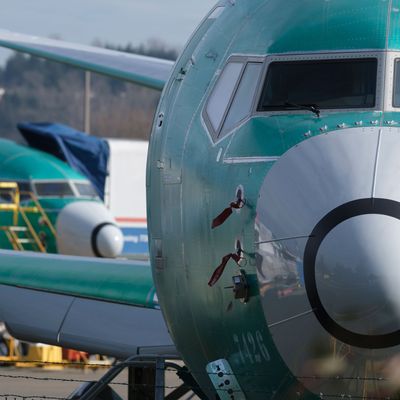
Yesterday’s news from Boeing was of a now-familiar variety: grim. The company announced that it would temporarily stop building the 737 Max, the troubled jet that has spent most of the year grounded in the wake of two fatal crashes. Even after a nine-month-long string of bad news, the decision registers as particularly dire, tantamount to an admission that the company sees no clear end to the Max’s troubles.
There is a great deal of ruin in a country, Adam Smith observed, and the same is true for a $200 billion globe-straddling conglomerate whose sprawl embraces space launch, satellites, and military aircraft, so at first even the grounding of the company’s best-selling passenger jet didn’t seem like an existential crisis. The company had some 5,000 orders on the books for the 737 Max alone, enough to keep the production line humming for years. It seemed obvious that Boeing would fix whatever was wrong with the planes, get them back in the air, and return to booking exorbitant profits.
But that’s not what happened. As Boeing struggled to fix the Max’s flaws, more turned up. The grounding dragged on, and despite Boeing’s repeated assurances that all would soon be set right, the end never seemed to draw any closer. Stakeholders got increasingly fed up. Customers dropped their orders. Regulators expressed frustration and dissatisfaction. The press piled on, dubbing the Max a “death machine.”
Though it didn’t signal an immediate hit to revenue, the widespread loss of faith represents tremendous long-term damage to Boeing. Air travel requires an exceptional degree of trust. A century of reliable engineering had given Boeing a rock-solid reputation. This not only allowed Boeing to profitably feed the world’s fast-growing demand for passenger jets, it helped them bring out new models swiftly and inexpensively, with minimum oversight from regulators.
That’s gone now. After working hand in hand with Boeing for years, the FAA is now pushing back. After Boeing released a statement on November 11 declaring that it anticipated recertification from the FAA “this quarter,” FAA administrator Steve Dickson released a video to FAA employees in which he said that despite “a lot of pressure to return this aircraft to service quickly … I want you to take the time you need, and focus solely on safety.” Even worse, regulators around the world have declared that, instead of accepting the FAA’s certification, they’ll need to put the plane through their own paces before clearing it to fly.
As recently as last month, Boeing was still trying to bluster through. Boeing chairman David Calhoun and CEO Dennis Muilenburg each gave long public interviews in which they attempted to assure the public that all would soon be well. “This could be the safest plane ever,” said Muilenburg, overlooking the statistical impossibility of a plane that had already killed 338 people being safer than models like the 787 or A350, which had never killed anyone.
The charm offensive wound up being overshadowed by damning revelations during congressional hearings. Earlier this month, former Boeing manager Ed Pierson told the House Transportation Committee that conditions on the 737 production line were so problematic that “for the first time in my life … I’m hesitant about putting my family on a Boeing airplane.”
Yesterday’s decision to halt production came at the end of a two-day board meeting, and reflects a painful reality: that even as the crisis has ground steadily along, the anticipated return to service has only receded ever-further into the future. With undeliverable aircraft piling up, apparently even Boeing has lost confidence that newly built machines will be handed over to customers anytime soon.
Maybe they never will be. Back in March, Boeing was sure that the fix would be simple and quick. By now, it’s not entirely clear that it’s fixable at all. For historical reasons, Boeing designed a plane that is dynamically unstable. To correct for that instability, they added an automated system — the ill-starred MCAS — that would kick in when needed. But that system itself proved capable of destroying the plane. Last month, it emerged that a Transport Canada official had written to international regulators saying that before the Max could return to flight, the MCAS “has to go.” But if that’s the case, the aircraft’s dynamic instability will be left exposed. The plane will be uncertifiable. Worst-case scenario: hundreds of planes get pulped and an order book worth half a trillion dollars gets tossed out the window.
How much ruin Boeing has left remains to be seen. Over the past year, the company has received much criticism for shifting its priorities from aircraft engineering to financial engineering, pouring billions into dividends and share buybacks while skimping on the development of new aircraft. But truth be told, its focus on share price has been successful. While share prices are down 25 percent from their all-time high, they’re still more than double what they were when the 737 Max first flew in 2016.
In this regard, at least, Boeing apparently sees itself as being on the right track. On the same day Boeing announced the Max production halt, they also declared that they’d be issuing a quarterly dividend of just over $2 a share.






























